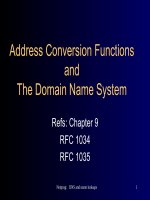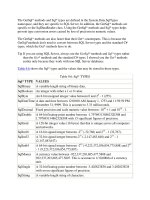Tài liệu Network Application Security Using The Domain Name System pptx
Bạn đang xem bản rút gọn của tài liệu. Xem và tải ngay bản đầy đủ của tài liệu tại đây (2.96 MB, 109 trang )
Royal Institute of Technology
Dept. of Numerical Analysis and Computer Science
Network Application Security Using
The Domain Name System
by
Simon Josefsson
TRITA-NA-E01107
NADA
Nada (Numerisk analys och datalogi) Department of Numerical Analysis
KTH and Computer Science
100 44 Stockholm Royal Institute of Technology
SE-100 44 Stockholm, SWEDEN
Network Application Security Using
The Domain Name System
by
Simon Josefsson
TRITA-NA-E01107
Master’s Thesis in Computer Science (20 credits)
at the School of Matematisk-datalogisk linje,
Royal Institute of Technology year 2001
Supervisor at Nada was Mikael Goldmann
Examiner was Stefan Arnborg
Abstract
A major problem for a distributed security system is the management of cryp-
tographic keys. Public key techniques are often used to overcome many of the
problems. However, successful use of public key techniques in large systems such
as the Internet requires a certificate directory, that is, a mechanism to locate and
retrieve the public keys. In this thesis we explore how a common name lookup
mechanism, the Domain Name System (DNS), can be used to provide this func-
tionality. We show how the idea can be implemented in a secure mail application
together with S/MIME. We compare the DNS lookup mechanism with traditional
Directory Access Protocol based systems and identify weaknesses and strenghts.
We also discuss and suggest a solution to privacy threats that arise because of recent
security additions to the DNS, namely Secure DNS.
S
¨
akerhet f
¨
or n
¨
atverksapplikationer
med Dom
¨
annamnssystemet
Sammanfattning
Vid design av s
¨
akra distribuerade system
¨
ar hanteringen av kryptografiska nycklar
ett grundl
¨
aggande problem. Publik-nyckel (PK) teknologi anv
¨
ands ofta f
¨
or att l
¨
osa
m
˚
anga av dessa problem. F
¨
or att PK-teknik ska vara praktiskt till
¨
ampbart i stora
system som t.ex. Internet kr
¨
avs en certifikatsbibliotekstj
¨
anst som anv
¨
ands f
¨
or att
lokalisera och h
¨
amta publika nycklar. Den h
¨
ar rapporten beskriver hur den vanli-
ga namnuppslagningstj
¨
ansten, Dom
¨
annamnssystemet (DNS), kan anv
¨
andas f
¨
or att
l
¨
osa det problemet. Vi visar hur DNS kan anv
¨
andas f
¨
or att
˚
astadkomma s
¨
aker epost
tillsammans med S/MIME. Vi j
¨
amf
¨
or DNS med den traditionella bibliotekstj
¨
ansten
som
¨
ar baserad p
˚
a Directory Access Protocol och identifierar f
¨
ordelar och nackde-
lar. Avslutningsvis diskuterar vi, och f
¨
oresl
˚
ar en l
¨
osning p
˚
a, hot mot personlig in-
tegritet; hot som
¨
ar en f
¨
oljd av en nyligen f
¨
orslagen s
¨
akerhetsut
¨
okning som kallas
Secure DNS.
iii
iv
Preface
This thesis was presented to Stockholm University as partial fulfillment of the re-
quirements for the degree of Master of Science in Computing Science.
The work was performed at RSA Security in Stockholm, Sweden. Supervisor at
RSA Security was Magnus Nystr
¨
om. Mikael Goldmann was supervisor at the De-
partment of Numerical Analysis and Computer Science (NADA). Examiner was
Stefan Arnborg.
v
vi
Acknowledgements
I would like to thank my supervisors, Magnus Nystr
¨
om and Mikael Goldmann, for
advice and comments on my work, and their suggestions that helped to improve
this report. All errors are of course my own.
The idea to use public key encryption of owner names in the Secure DNS “NO”
record was suggested by Jonas Holmerin (the idea later developed into hashing).
This report was written in L
A
T
E
X [61] and illustrated with Dia [62]. Also, BibTeX,
Emacs, ImageMagick and other free and open source software were instrumental
to the creation of this document.
vii
viii
Contents
Preface v
Acknowledgements vii
Contents ix
List of Figures xii
List of Tables xiii
1 Introduction 1
1.1 Outline of the Report . . . . . . . . . . . . . . . . . . . . . . . . 2
2 Background 3
2.1 Cryptography . . . . . . . . . . . . . . . . . . . . . . . . . . . . 3
2.2 Internet and the Domain Name System . . . . . . . . . . . . . . . 9
2.3 Public Key Infrastructure . . . . . . . . . . . . . . . . . . . . . . 11
2.4 Domain Name System . . . . . . . . . . . . . . . . . . . . . . . 13
2.5 Electronic Messaging . . . . . . . . . . . . . . . . . . . . . . . . 14
2.5.1 Secure Electronic Messaging . . . . . . . . . . . . . . . . 14
2.5.2 Multipurpose Internet Mail Extension . . . . . . . . . . . 15
2.5.3 Privacy Enhanced Mail . . . . . . . . . . . . . . . . . . . 16
2.5.4 Pretty Good Privacy . . . . . . . . . . . . . . . . . . . . 17
2.5.5 Security Multiparts for MIME . . . . . . . . . . . . . . . 17
2.5.6 Secure MIME . . . . . . . . . . . . . . . . . . . . . . . . 17
3 Use Cases 19
3.1 Email Client . . . . . . . . . . . . . . . . . . . . . . . . . . . . . 19
3.2 Certificate Publishing . . . . . . . . . . . . . . . . . . . . . . . . 24
4 LDAP and DNS as Certificate Directories 25
4.1 Why Focus on LDAP and DNS? . . . . . . . . . . . . . . . . . . 25
4.1.1 How the Certificates are Used . . . . . . . . . . . . . . . 26
4.1.2 How the Directory is Used . . . . . . . . . . . . . . . . . 26
ix
4.2 Locating Certificates . . . . . . . . . . . . . . . . . . . . . . . . 26
4.2.1 Certificate Naming . . . . . . . . . . . . . . . . . . . . . 27
4.2.2 Lightweight Directory Access Protocol . . . . . . . . . . 29
4.2.3 Domain Name System . . . . . . . . . . . . . . . . . . . 30
4.3 Updating Certificates in a Directory . . . . . . . . . . . . . . . . 31
4.3.1 Updating in LDAP . . . . . . . . . . . . . . . . . . . . . 31
4.3.2 Updating in DNS . . . . . . . . . . . . . . . . . . . . . . 32
4.3.3 Conclusions . . . . . . . . . . . . . . . . . . . . . . . . . 33
4.4 Performance and Overhead . . . . . . . . . . . . . . . . . . . . . 34
4.4.1 Caching in DNS and How it Affects Certificate Lookup . . 34
4.4.2 The Domain Name System Protocol . . . . . . . . . . . . 35
4.4.3 The Lightweight Directory Access Protocol . . . . . . . . 36
4.4.4 Round Trips . . . . . . . . . . . . . . . . . . . . . . . . . 37
4.4.5 Packet Size . . . . . . . . . . . . . . . . . . . . . . . . . 40
4.4.6 Computer Resource Utilization . . . . . . . . . . . . . . . 42
5 DNS Security Considerations 45
5.1 Secure DNS . . . . . . . . . . . . . . . . . . . . . . . . . . . . . 46
5.1.1 Data Non-existence . . . . . . . . . . . . . . . . . . . . . 47
5.1.2 NXT Chaining . . . . . . . . . . . . . . . . . . . . . . . 49
5.2 Data Non-existence with Minimum Disclosure . . . . . . . . . . 50
5.3 Implementing the Idea in DNS . . . . . . . . . . . . . . . . . . . 52
6 Conclusions 53
Bibliography 55
Index 60
Appendices 65
A NO Resource Records 65
B Sample Certificates 81
C Benchmarking Tool 89
x
List of Figures
2.1 Some basic cryptographic concepts . . . . . . . . . . . . . . . . . 4
2.2 Simple key transfer . . . . . . . . . . . . . . . . . . . . . . . . . 5
2.3 Digital Signature . . . . . . . . . . . . . . . . . . . . . . . . . . 6
2.4 A digital certificate . . . . . . . . . . . . . . . . . . . . . . . . . 7
2.5 Secure key transfer . . . . . . . . . . . . . . . . . . . . . . . . . 8
2.6 Brief example of the DNS hierarchy . . . . . . . . . . . . . . . . 10
2.7 Players of a PKI . . . . . . . . . . . . . . . . . . . . . . . . . . . 11
2.8 Message Handling System Model . . . . . . . . . . . . . . . . . 15
2.9 The PEM Public Key Infrastructure . . . . . . . . . . . . . . . . 16
3.1 A sample message . . . . . . . . . . . . . . . . . . . . . . . . . . 20
3.2 Selecting security functions from menu . . . . . . . . . . . . . . 20
3.3 Choosing the secure messaging technology to use . . . . . . . . . 21
3.4 Select certificate source . . . . . . . . . . . . . . . . . . . . . . . 21
3.5 Select encryption key to use . . . . . . . . . . . . . . . . . . . . 22
3.6 Query for more recipients . . . . . . . . . . . . . . . . . . . . . . 22
3.7 The original message tagged for encryption . . . . . . . . . . . . 23
3.8 Encrypted S/MIME message . . . . . . . . . . . . . . . . . . . . 23
3.9 Sample LDIF data . . . . . . . . . . . . . . . . . . . . . . . . . . 24
3.10 Corresponding DNS data . . . . . . . . . . . . . . . . . . . . . . 24
4.1 Example X.500 Directory . . . . . . . . . . . . . . . . . . . . . . 28
4.2 Update Certificate . . . . . . . . . . . . . . . . . . . . . . . . . . 31
4.3 DNS envelope . . . . . . . . . . . . . . . . . . . . . . . . . . . . 35
4.4 LDAP packet, with some structures expanded . . . . . . . . . . . 36
4.5 Round Trip between two entities . . . . . . . . . . . . . . . . . . 37
4.6 Setting up a TCP connection . . . . . . . . . . . . . . . . . . . . 37
4.7 Tearing down a TCP connection . . . . . . . . . . . . . . . . . . 37
4.8 Round trips in a DNS Query over UDP . . . . . . . . . . . . . . . 38
4.9 Round Trips in a DNS Query . . . . . . . . . . . . . . . . . . . . 38
4.10 Round trips in a LDAP Query . . . . . . . . . . . . . . . . . . . 39
4.11 Bytes required to transfer a certificate with a 1024 bit RSA key
with DNS and LDAP . . . . . . . . . . . . . . . . . . . . . . . . 43
4.12 Queries per second to look up a certificate . . . . . . . . . . . . . 44
xi
5.1 Naive data non-existence implementation . . . . . . . . . . . . . 47
5.2 “NXT” Data-nonexistence implementation . . . . . . . . . . . . . 50
5.3 Minimum information disclosure and data non-existence . . . . . 51
5.4 Final example of how minimum information disclosure and data
non-existence would work using NO records . . . . . . . . . . . . 52
B.1 512 bit RSA certificate . . . . . . . . . . . . . . . . . . . . . . . 82
B.2 1024 bit RSA certificate . . . . . . . . . . . . . . . . . . . . . . . 83
B.3 2048 bit RSA certificate . . . . . . . . . . . . . . . . . . . . . . . 84
B.4 512 bit DSA certificate . . . . . . . . . . . . . . . . . . . . . . . 85
B.5 1024 bit DSA certificate . . . . . . . . . . . . . . . . . . . . . . 86
B.6 VeriSign 1024 bit RSA certificate . . . . . . . . . . . . . . . . . . 87
xii
List of Tables
4.1 Update operations supported in DNS and LDAP . . . . . . . . . . 33
4.2 Authentication support in DNS and LDAP . . . . . . . . . . . . . 33
4.3 Number of round trips for a query using DNS and LDAP . . . . . 40
4.4 Typical certificate sizes . . . . . . . . . . . . . . . . . . . . . . . 40
4.5 Overhead of various layers . . . . . . . . . . . . . . . . . . . . . 41
4.6 Bytes required to transfer a certificate that contains a 1024 bit RSA
key with DNS and LDAP . . . . . . . . . . . . . . . . . . . . . . 42
4.7 Queries per second to look up a certificate . . . . . . . . . . . . . 43
5.1 Example of (partial) DNS information for a zone josefsson.org . . 49
5.2 Example of non-existence proof data for data in table 5.1 . . . . . 49
5.3 Example of non-existence proof data for data in table 5.1 . . . . . 51
xiii









